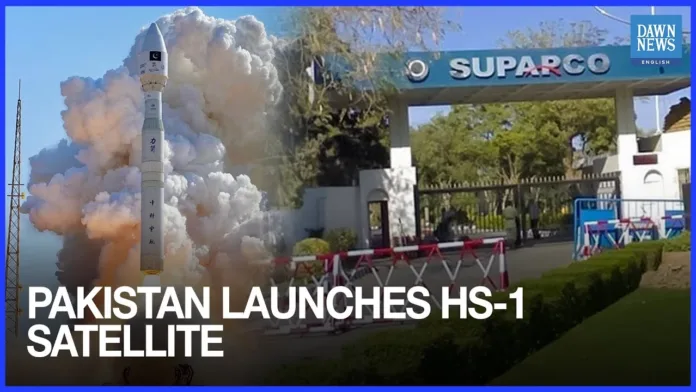Table of Contents
Pakistan has reached a significant milestone in its space exploration journey with the successful launch of its first hyperspectral satellite, HS-1, from China. The launch took place in October 19, 2025 from the Jiuquan Satellite Launch Centre aboard a Long March 2C rocket, marking a new chapter in Pakistan’s technological advancement. This achievement, led by the Pakistan Space and Upper Atmosphere Research Commission (SUPARCO), opens new opportunities for the country to benefit from advanced space technology. The launch marks a major step forward not only in Pakistan’s technological capabilities but also in its ability to support national development, environmental sustainability, and disaster resilience.
Squaredtech highlights this accomplishment as a key moment that enhances Pakistan’s capacity to use space data in vital fields like agriculture, urban planning, and disaster preparedness. The HS-1 satellite’s specialized imaging technology, capable of capturing data across an impressive 130 contiguous spectral bands, offers precision and clarity far beyond that of traditional multispectral satellite imagery.
Hyperspectral Satellite Technology Explained and Its Significance
A hyperspectral satellite captures data in many narrow spectral bands, allowing for detailed analysis of various materials on the Earth’s surface.
Here’s the thing about this technology: Unlike older multispectral satellites, which only gather information in a few, broad wavelength ranges (think Red, Green, and Blue, plus a couple of others), hyperspectral systems like HS-1 are a huge leap forward. They divide the spectrum into hundreds of contiguous bands, moving from color photography to chemical fingerprinting. What this really means is that the satellite produces ultra-precise imaging that doesn’t just show where a field is, but can actually distinguish between different types of vegetation, soil conditions, water quality, and even the subtle chemical signatures that indicate crop disease or pollution.
The advanced data captured by HS-1 will allow Pakistan to improve agricultural monitoring by mapping crop health and soil moisture levels with great accuracy. This means farmers and policymakers will receive timely information to increase crop yields and manage resources efficiently. This level of precision is critical; some experts project the satellite could enhance agricultural yield estimation by 15-20%. This spectral detail allows analysts to move beyond simple land-cover mapping to material and chemical identification.
With this capability, the satellite will also enhance early warning and post-event analysis of natural disasters, including floods and landslides. The HS-1 satellite’s precise imaging will support targeted disaster response and recovery efforts by providing accurate maps of affected areas.
Check Out Similar Article of Check Out Similar Article of SpaceX’s Starship Launch to Revolutionize Satellite Deployment! Published on January 6th, 2025 SquaredTech
National Impact and Strategic Importance of HS-1
The launch comes at a time when Pakistan is focused on sustainable development and climate resilience. Chairman of SUPARCO, Mr. Muhammad Yousaf Khan, warmly congratulated the nation and credited the government for its vital role in supporting this project.He emphasized that the satellite data is poised to revolutionize agriculture, bolster climate response, and allow for smarter management of natural resources.
In addition to agriculture and environment, HS-1 will support major economic projects such as the China-Pakistan Economic Corridor (CPEC). By identifying geological hazards early, the satellite will help guide infrastructure development, focusing on safety and sustainability. This Sino-Pakistani technological alignment goes beyond economics; it’s accelerating the National Space Policy’s Vision 2047 and subtly enhancing Pakistan’s independent surveillance capacity in a competitive regional environment.
Squaredtech observes that the true value of this mission lies in the follow-through. The satellite will enter a two-month in-orbit testing and calibration period before the data becomes fully operational and accessible. More critically, this mission will spur national growth only if SUPARCO ensures the data is easily accessible and usable by private-sector Agritech companies and researchers, democratizing this powerful new resource. This application demonstrates how space technology can integrate with national development strategies to reduce risks and maximize benefits.
Project Director Mr. Mushtaque Hussain Soomro praised the dedicated efforts of the mission team and highlighted the significance of HS-1 in Pakistan’s expanding space ambitions. The satellite elevates Pakistan’s position as an emerging leader in space technology focused on sustainable progress.
Stay Updated: Space


